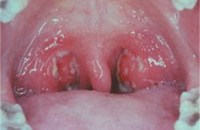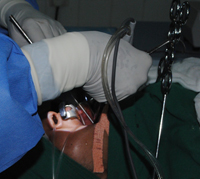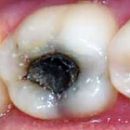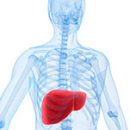Adenoids are the pathological growths of pharyngeal or nasopharynten almonds that can appear isolated, and can be combined with increasing palatine almonds.
Content
Adenoid description
Adenoids or, as they are also called, adenoid vegetation, it is the pathological growth of pharyngeal or nasopharynxal almonds. These growths can appear isolated, and can be combined with increasing the sky almonds.
 Sulfgesting Almond is often involved in a pathological process, which may be accompanied by both a change in the number of cells forming almond and their growth, but the result is always an increase in almonds in the amount of. Sulfing Almond is well developed in children. Lymphoid fabric, which forms almond, together with other similar formations of the pharynx, forms an immune barrier that protects the child from infections transmitted by air-droplet. With a 12-year-old, sizzling almond begins to decrease in size, some adults are completely atrophied.
Sulfgesting Almond is often involved in a pathological process, which may be accompanied by both a change in the number of cells forming almond and their growth, but the result is always an increase in almonds in the amount of. Sulfing Almond is well developed in children. Lymphoid fabric, which forms almond, together with other similar formations of the pharynx, forms an immune barrier that protects the child from infections transmitted by air-droplet. With a 12-year-old, sizzling almond begins to decrease in size, some adults are completely atrophied.
The growth of pharyngeal almond or adenoids are more common in children 3-10 years old. Sometimes they are revealed in the first year of the child's life, and sometimes, on the contrary, no concerns are not delivered to adolescence. The development of the disease is promoted by frequent respiratory, viral and microbial infections, children's infections, for example, measles, scaryttern, diphtheria. The situation exacerbates the presence of a tendency to allergic reactions and a decrease in immune protection of the body. Often revealed hereditary predisposition to the disease.
Manifestations of adenoids
The main symptom of adenoids or adenoid vegetation is a violation of nasal respiration, the degree of severity of which is determined by the size of the growths of pharyngeal almond. With a minor increase in the latter, breathing through the nose can be difficult only during sleep or at easy cold, with adenoids of the third degree nasal breathing becomes, practically impossible.
 The second symptom of adenoids are abundant mucous membranes from the nose associated with chronic swelling and inflammation of the mucous membrane. Constant «dampness» Under the nose causes irritation and swelling of the upper lip, sometimes the skin is inflamed so much that eczema develops. The upper lip is covered with wet erosions and crusts, it hurts and this is concerned about the child. The mucus released from the nasal strokes is lifted in the nasopharynx and the throat, the child is periodically cleared.
The second symptom of adenoids are abundant mucous membranes from the nose associated with chronic swelling and inflammation of the mucous membrane. Constant «dampness» Under the nose causes irritation and swelling of the upper lip, sometimes the skin is inflamed so much that eczema develops. The upper lip is covered with wet erosions and crusts, it hurts and this is concerned about the child. The mucus released from the nasal strokes is lifted in the nasopharynx and the throat, the child is periodically cleared.
Because of the difficult nasal breathing, sleep is disturbed, the patient breathes open mouth, why the oral mucosa and the pharynx dries, snoring appears. Sleep anxiety, anxiety, lead to the fact that the child often wakes up, becomes sluggish and apathetic, it decreases attention, the performance falls, imaginary processes are difficult, the memory is impassable. All this becomes the reason for lower education in school and, as a result, the reason for the occurrence of psychotrauming situations in an educational institution and at home.
Adenoids, as a rule, close the Estarchy tube, connecting the nasopharynk with the inner ear, thereby leading to a decrease in hearing, sometimes significant. In addition, the disease leads to a distortion of the child's speech, it becomes bellucrative, silent. Early children and are at all difficult in mastering speech skills. Continuous inflammation and an increase in pharyngeal almond contributes to a violation of the outflow of lymph and venous blood from the brain. The consequence of this becomes steady gravity in the head and headache.
The face of a child suffering from adenoids has a very distinctive appearance, it is usually called «Adenoid face» or «External adenoidism». The child's mouth is constantly open, the lower jaw disperses, the nasolabious folds are smoothed, out of mouth in the corners of the lips flows saliva. Face skin and mucous pale, under the eyes of bluish circles.
 Adenoids lead in gradual deformation of the facial skeleton. The child is formed an irregular bite, the upper heaven becomes high and acquires an arcoal shape, the asymmetry of the face is manifested. The absence of timely treatment of adenoids leads to a formulation of the chest, the formation of the depressions in the region of the sternum, violation of the ventilation of the lungs, which further aggravates the position. The amount of red blood cells, hemoglobin decreases in the blood, anemia is developing. Oxygen starvation of a growing organism leads to a delay in development, both physical and mental.
Adenoids lead in gradual deformation of the facial skeleton. The child is formed an irregular bite, the upper heaven becomes high and acquires an arcoal shape, the asymmetry of the face is manifested. The absence of timely treatment of adenoids leads to a formulation of the chest, the formation of the depressions in the region of the sternum, violation of the ventilation of the lungs, which further aggravates the position. The amount of red blood cells, hemoglobin decreases in the blood, anemia is developing. Oxygen starvation of a growing organism leads to a delay in development, both physical and mental.
At adenoids, the activity of the gastrointestinal tract is often disturbed, the night incontinence of urine is celebrated, Korea arises, laryngospasm, often attacks of asthmatic cough and suffocation.
Adenoids contribute to the development of infectious diseases of the nose, pharynx and other respiratory tract. Against the background of adenoids, the inflammation of the sky tonsils (angina) is developing, accompanied by an increase in body temperature to 390s, a feeling of dryness, crosses, pain in the nasopharynx. Along with a runny nose, the patient begins to disturb the launching of the ears, sometimes pain in the ear. At night, the parole cough arises, the patient seeks to dilute, but the nasophack mucus stands out with difficulty. Small children may increase submandibular, cervical and occipital lymph nodes. Frequent complications in the form of eustachiotic and otitis.
Frequent respiratory infections contribute to the development of chronic inflammation of the sky almond – Chronic adenoiditis. The disease is characterized by a violation of working capacity, lethargy, lack of appetite, the occurrence of vomiting during eating. Plugging of the purulent in the underlying respiratory tract leads to the occurrence of cough, especially pronounced at night. Temperature of the body constantly holds on subfebris values. In the inflammation often involve the incomplete sinuses, throat, larynx, trachea. Children often suffer from broncho-pulmonary diseases.
Diagnosis of adenoids
The diagnosis of adenoid is based on the data of the finger research of the nasopharynx, the results of rhinoscopy and x-ray. If a child has signs of adenoid growth, you should seek advice with a rhinootolaryngologist. Symptoms similar to adenoids have diseases such as a wealth of nasopharynx fibroid, as well as nasopharynx tumors. Difficult breathing may occur not only with adenoids, sometimes its cause can be the curvature of the nasal partition, hypertrophic rhinitis, nasal cavity tumors.
Treatment and prevention of adenoids
Treatment of adenoids, mainly surgical. The indication for the operation is not the growths themselves, but the nature of those violations that arise as a result of their existence. Thus, with the first degree adenoids and a minor impaired of nasal respiration, a conservative treatment is recommended: a 2% compartment of the protargol or collargol solution, which has an ignition effect and leading to a decrease in almonds, as well as physiotherapeutic procedures. Considering the overall impact of the disease on the child's body, it is shown the appointment of fish oil (omega-d3-polyunsaturated amino acids), calcium preparations, vitamins C and D. Favorable effects are provided by climatic procedures, rest in the southern resorts, hydrophole, washing the nose of sea water.
 With adenoids of the second degree, and sometimes even with the first degree adenoids, causing a significant impairment of breathing through the nose and the development of chronic oxygen starvation syndrome, operational treatment is recommended. Tightening with surgery should not be tightened, since adenoids lead to violation of the vital activity of the entire children's body and the emergence of irreversible consequences. The essence of the adenotomy operation is to remove the born parts of the pharyngeal almond. Unfortunately, in children who are inclined to allergies, adenoids often recur, therefore surgical treatment is more often carried out against the background of desensitizing therapy, which reduces the body allergyization.
With adenoids of the second degree, and sometimes even with the first degree adenoids, causing a significant impairment of breathing through the nose and the development of chronic oxygen starvation syndrome, operational treatment is recommended. Tightening with surgery should not be tightened, since adenoids lead to violation of the vital activity of the entire children's body and the emergence of irreversible consequences. The essence of the adenotomy operation is to remove the born parts of the pharyngeal almond. Unfortunately, in children who are inclined to allergies, adenoids often recur, therefore surgical treatment is more often carried out against the background of desensitizing therapy, which reduces the body allergyization.
The prevention of adenoids is to temper the child, strengthening the body's protective forces by periodic reception of the vitaminomineral complexes, carrying out preventive measures during the ORVI epidemics, timely and competent relief of acute inflammatory processes of nose and nasopharynx.









